In this article, 32 of the best flowering houseplants to use in your home will be discussed. Normally we look for plants in our homes to not only brighten it but also add splashes of colour.
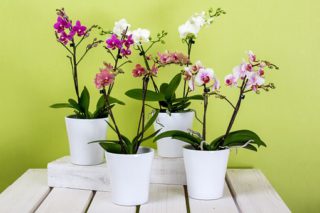
Plants in our homes fall into two separate categories of those that are grown for the leaves, or those that are grown for their flowers. The latter will be discussed in this article.
The plants that are suggested are not only beautiful to look at but come in many different colorful flowers, and are relatively easy to look after. Some flowers suggested will take more looking after and these are highlighted as we go along. How to look after houseplants have been discussed here.
ACHIMENES (Cupid’s Bower)
Achimenes is not a difficult plant to look after and will reward the owner with numerous flowers in summer and early autumn, where the blooms are purple-blue in colour. In addition to the colorful blooms, Cupid’s bower has attractive, hairy leaves.
The plants can become leggy, so keep pinching out the tops as the stems grow as this will encourage side shoots to form, and it will keep it bushy. The plant may need some support to prevent the long, weak stems from flopping all over the place.
Grow Achimenes in brightly lit conditions but away from direct sunlight. It will grow up to 50cm in height and would need regular watering and application of liquid fertilizer during the summer months.
BILLBERGIA (Queen’s Tears)

This bromeliad is one of the easiest one of the family to grow, where it is grown for its unusual shaped flowers. These flowers come from bright pink bracts. The greyish-green leaves are attractive but not as interesting as the foliage of the other bromeliads.
Billbergia can stand the lowest of temperature of all the bromeliads, where it can grow up to 1m in height, The plant needs a good amount of sunlight and regular feeding-once a month- with a liquid fertilizer. If this is done right flowers will be produced from late spring to late summer.
CAMPANULA ISOPHYLLA (Italian Bellflower)
This native of Northern Italy makes a popular indoor plant. This 50cm tall delicate plant produces masses of mauve-blue flowers from summer to autumn. Best grown in a container on the edge of a tall shelf, so the flowers can cascade and the flowers ad-mired at eye level. This easy to grow plant requires little care, just some water in the summer months, an occasional feeds and that is all. Grow it in a bright area.
CLIVIA
This plant originates from South Africa, where strap-like arching leaves that emerges from a large bulb. In spring, stout stems appear from these leaves bearing a flower head of exotic red or orange flowers.

This indoor bulb will grow up to 75cm in height where it would appreciate being grown in good, bright light. Clivia is tolerant of most growing conditions and can even take light shade. Saying all this, it is not very easy to grow and to get it to flower, as it may require some patience. Needs to be watered freely in summer sparingly in winter. Feed regularly in spring and summer, but it does not like to be disturbed or moved.
CONVALLARIA (Lily of the Valley)
This outdoor plant can be cultivated as an indoor plant because it brings the sight and scents of spring into the home in the depths of winter.

This 25cm tall plant produces small, white bell-shaped flowers upon slender, upright green stalks. The flowers soon fade, where it prefers to be grown in moist compost in cool, low humidity growing conditions.
Flowering can take place from mid-winter where they make interesting centerpieces. Once finished flowering you can plant it outside in the garden in containers. You will need to buy new stock every year.
CYCLAMEN

These add splashes of colour in autumn and winter, where cultivars of cyclamen perscium appear in shops. A good plant for over the Christmas period. The flowers are available in pink, white, red and purple, over dark green, variegated leaves. Some even have a scent.
When leaves are present, the plant will require to be watered normally and to get an occasional misting. Feed monthly with half-strength potash fertilizer, in order to help it produce more flowers It needs to be placed in an area of good light but away from direct sunlight.
CYMBIDIUM
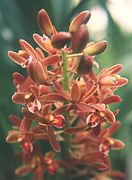
This makes a spectacular indoor flowering specimen where tall (up to 90cm in height) arching spikes are produced over insignificant green leaves. The spikes are covered with flowers. Each flower comprises five petals and a central lip that often contrast in colour. The flowers itself have cultivars that are yellow, pink, red, green or white in colour.
To be in best flowering condition, the plant needs many hours of sunlight so it needs to be placed on a sunny windowsill.
Cymbidium should be watered moderately in summer and occasionally fed with liquid fertilizer. Water infrequently in winter.
DENDROBIUM
The flowers of this orchid come in many different sizes, some are large and borne sparsely, while others are small, but produced in larger numbers. The leaves themselves are not particularly interesting as they are dark green and erect.
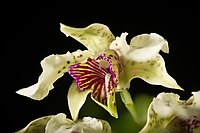
This plant can be small as 15cm but on the other hand, it can grow up to 1m high.
The attractive orchid needs cool temperatures but high humidity in order to thrive.
Dendrobium nobile has unusual chunky stems, from which the flowers emerge. These are in fact pseudobulbs.
Grow this orchid in light shade and in summer, water freely and apply liquid fertilizer every few weeks. In autumn to spring do not water at all.
GARDENIA

This large houseplant can grow up to 2m tall. It is more of a shrub than an indoor plant, where it can be grown outdoors in milder areas. Gardenia has everything, the showy, double flowers come in subtle shades of cream, white and yellow, and yet has the most intoxicating scent. The leaves themselves are attractive where they are glossy, green in nature.
Grow this houseplant in a good, bright area. Gardenia needs plenty of attentive care if the flowering buds do not get the right conditions, they will drop off. Apart from good light, you must ensure that the compost never dries out.
HAAGEOCEREUS
This is an attractive cactus that will grow up to 70cm in height if treated well. Its stems are cylindrical in nature and can grow very large, compared to other cacti and succulents grown in homes.

In summer, exotic red flowers appear. Apart from the flowers, interesting lies in its spines. The stems are dark green in colour but the spines are black with yellow tips.
Grow this plant in a well-ventilated area in direct sunlight. You will need to water well over summer allowing the compost to dry out between watering. Keep the compost dry in winter.
HELIOTROPIUM (Heliotrope)

Heliotrope is one of the best perfume of all indoor flowering plants. This 45cm tall plant has pretty mounds of tiny violet-purple flowers that are a delight to look at but it is their scent that steals the show. The leaves are not particularly interesting to look at.
The plants are also easy to look after, and they are often treated as a bedding plant, so can take droughts or temperature changes with little fuss. Water moderately in summer, more sparingly in winter. Feed once a month in spring and summer with a liquid fertilizer. Needs to be pruned regularly.
HIBISCUS
There are a large number of indoor hibiscus available, along with their reputation to be easy to look after, and their free-flowering nature makes it an ideal houseplant. The flowers are stunning in shape and are available in almost every colour and shade.
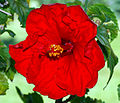
Hibiscus rosa-sinensis (Rose of China) is the species grown as a houseplant. It has dark, glossy green leaves and large, red, orange or white flowers. Other cultivars all have the same glossy leaves but have a greater variation in flower colours and shape. The more desired colours are the dark reds and oranges ‘Crown of Bohemia’ and ‘Copperi’ are good examples.
As long as you have a sunny location in your home, hibiscus will be happy. On the other hand, it will not tolerate the heat of the midday sun in summer, so it is advised to offer some shade. They need plenty of water in summer and would benefit from regular misting.
This plant can grow up to 2.5m tall and so will need regular pruning to keep it in check. Hibiscus can drop flowering buds and this will tend to occur if the plants are allowed to dry out or there is a temperature change.
HIPPEASTRUM (Amaryllis)
What will Christmas be without the amaryllis, which brings so much colour to that time of year.

The flowers of Amaryllis have tall erect flower stems, growing up to 70cm tall that can produce 15cm diameter flowers. The flowers tend to be pink, red, or white, or a mixture of the three.
Usually, you plant the bulb in October to get it to flower around Christmas time. The usual time between planting and the flowers opening is 6 to 8 weeks, so you can time when to plant the bulb. Bulbs planted later will also flower later.
The leaves are nothing special but are light green and erect in nature.
You need to place the plant in a warm area but away from direct sunlight. When planting the bulb you need to keep the compost almost dry until new growth appears. Do not plant the bulb all the way down, as this can rot the bulb. It is better to plant the bulb with the top third planted above the level of the compost.
During the growing season water normally after flowering, remove the dead flowering spike. Keep feeding and watering until the leaves start to die back. If you do this right it may flower again later on in the year.
IMPATIENS (Busy Lizzie)
This impatiens so often used outside in bedding plants can be grown successfully as an indoor plant. Many will provide a colourful display during summer but will flower intermittently at the other months. Some also have attractive variegated and coloured leaves, which complements the flowers well.

The plants do not last long and are best treated as an annual and replaced after a year. This is not a problem as tip cuttings take very easily. To do this cutback old plants hard in late winter and in spring new flushes of new growth will appear. Pinch out regularly to keep it compact and to encourage it to bush out.
Care is straightforward by giving plants plenty of light and water in summer and mist the leaves occasionally. One of the few problems is that the flowering buds will drop if the compost is allowed to dry or if the humidity is too low. Feed once a month during the summer and water moderately in winter, where it will grow up to 90cm tall.
Busy Lizzies are more compact that the New Guinea hybrids but both are very attractive.
JASMINUM (Jasmine)
This 3m tall delicate, twining climbing stem of Jasminum polyanthum produces masses of tiny, scented star-shaped white flowers throughout winter and spring.

As Jasmine is a climbing plant, it would need its weak stems to be supported, otherwise, it will scramble all over the place, making it look unattractive. However, it is easy to train over a hoop of wire, but as it is a vigorous plant you can train it any way you wish to train it.
During summer water normally and feed with a high potash liquid fertilizer once a month. Grow it in a bright spot that does not get direct sunlight.
KALANCHOE
There are numerous species that can be grown indoors, all having succulent stems and leaves. The most popular is Kalanchoe blossfeldiana and its cultivars, where the species produce red, orange, white, or pink flowers that last for several weeks. Its natural flowering time is early spring but it can be easily manipulated into flowering at other times.
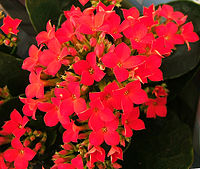
In garden centres, you will see them in flowers throughout the year. It is popular in flower around Christmas time. After flowering has finished you should give the plant a rest for around 6 weeks.
It can grow quite large up to 40cm in height and it needs its growing conditions to be met if it is to do well. It is an easy succulent to grow and does not need much time dedicated to it. All you need to do is keep the compost moist at all times and give it a rest after flowering. An occasional feed will also do no harm.
MEDINILLA (Rose Grape)

The rose grape makes an extremely unusual houseplant. This 2m long plant has large glossy leaves with pale, prominent veins. In spring and summer, dark pink, pendent flower stalks appear carrying clusters of small pink flowers overhung with large, pink wing-like bracts. The flower heads are very beautiful to look at.
Needs to be grown in direct sunlight and in high humidity. Water well during the growing season in summer, sparingly during winter. Feed once a month using a liquid fertilizer.
MILTONIOPSIS (Pansy Orchid)
The flowers of this orchid look like a pansy and hence its common name. They are good conservatory plants and can be grown successfully as indoor plants.

The flowers have large lower petals and smaller lower petals, giving them the distinctive pansy look. Each stem produces five flowers over light green erect stems. Many hybrids have been produced which produces yellow, red, brown or purple flowers.
Best grown in light shade in cool, humid conditions. This 23cm tall plant needs to be watered freely in summer.
NEMATANTHUS
This plant flowers are not brash or bold, but the subtle nature makes them very interesting. Nematanthus are easy to grow, especially for those who do not like their flowers to be brash or showy. The flowers are produced in summer and are mainly orange, red, or yellow and appear over dark, green grassy leave.
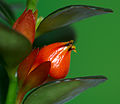
Grow this short 30cm plant in bright light, where the long and lax stems make an ideal specimen in an indoor hanging basket. Water moderately with soft water in summer, whilst it is actively growing. Less in winter but always in average humidity. You will need to feed monthly especially in the growing season.
ODONTOGLOSSUM
This genus contains some of the most dramatic flowers of the indoor orchids. Flowers are normally produced over autumn, winter, and spring. The flowers are often borne on tall, arching flowering spikes.
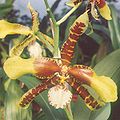
The most popular variety is the ‘Tiger Orchid’, which has 18cm across in diameter flowers that are bold red with brown and yellow spots, stripes and bands. Other varieties have white and yellow flowers.
This 50cm tall plant also has lush, upright green leaves. Grow it in bright, indirect sunlight in a very high humidity atmosphere. You will need to mist regularly. Water freely in summer and feed with a weak liquid fertilizer every few weeks.
ONCIDIUM
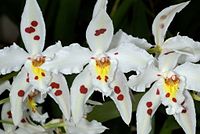
This plant loves to be grown in fairly cool conditions, where numerous small flowers are produced. This plant that grows up to 60cm has arching stems that gracefully droop below the main body of the plant. This trait makes the plant for growing in in-door hanging baskets filled with moss and orchid compost.
Oncidium flexuosum is the plant to look for, as it produces large yellow blooms with scallop-like lips. Normally flowers in autumn and winter, with red being the other flower colour possible. Needs plenty of indirect sunlight to do well, especially from the midday sun. Mist every day to keep humidity high.
PAPHIOPEDIDUM (Slipper Orchid)
The common name of slipper orchid is called because of the unusual shape of the lower petals, which resembles a slipper. These strange flowers also have an enlarged upper petal and two-winged like petals that are usually borne singly on dark stems.

This is not the only unusual thing about this flower, as the colour of the blooms are also unusual as well, as it is dominated by greens, browns and dark purples. The leaves are erect and green and are uninteresting.
This 30cm tall plant prefers to be grown in a bright position but not at full strength light. Water well and feed with a quarter-strength liquid fertilizer every few weeks. In winter move to full sunlight and keep watering.
PELARGONIUM (GERANIUMS)
These are so easy to grow that they make well behave indoor flowering plants. There is a huge variation in colour and form of their flowers and leaves. Some can even be encouraged to flower all year round. The classic pelargoniums are ideal indoor plants but regal and angel pelargoniums make even better houseplants.
Both groups have a good bushy shape and large showy flowers. Ivy-leaved pelargoniums are the most elegant having solid, waxy leaves and a trailing habit. This is more suitable for indoor hanging baskets.

The main flowering time for Pelargoniums is from late spring to mid-summer, in which they will require to be watered well. It is important that compost is not allowed to dry between watering. Do not overwater and this can cause rotting and fungal infections.
The plants like low humidity and therefore would appreciate being put outside during warm weather. Do not allow the leaves to get wet as this can lead to fungal infections.
In autumn, flowering will decrease and the plant can be dried out and kept almost dry for winter. In spring cut the plant back by at least a half to encourage new growth. If you are lucky and you have warm conditions, pelargoniums can flower throughout winter. To encourage this, keep plants in a light area and water less frequently than in summer. The plant can grow up to 40cm in height.
PERICALLIS (Cineraria)
It is almost universally known as cineraria, which is a good winter flowering plant. It has small domes of colorful daisy-shaped flowers above lush, dark green leaves. The flowers come in a mix of colours that are borne in winter or spring.

The flower domes are exceptionally colourful and most named strains include flower colours in their names. You can grow from seed but it is difficult to specify one colour. To avoid this it is better to buy plants already in bloom. Bicoloured petals are also possible, so extending the colour range.
Grow this 60cm tall plant in bright, indirect sunlight. In summer and whilst in flower keep the compost moist but not overly wet. Feed once every two weeks whilst in active growth, where the plant does not like being grown in high or low humidity conditions.
PHALAENOPSIS (Moth Orchid)
This is the most elegant of all the indoor orchids. It bears single arching flower spike dotted with heavily speckled flowers. The common name arises because of the open, rounded shaped of the flowers, makes it look like a moth. It needs heat to do well and flower frequently.

Place plants in a warm room with plenty of filtered sunlight. Water freely whilst in growth where you can feed with a weak liquid fertilizer every three weeks. Mist the plants once a day to keep the humidity high.
This 45cm tall plants will appreciate some water and full sunlight in winter, enough to keep the compost moist. After the flower spikes have faded remove them and not before.
RHODODENDRON (Azaleas)
All indoor rhododendron are commonly called azaleas. They bring an exotic touch to any home, as the large papery flowers evoke imagines of the Far East. The flowers come in shades of white, pink, red, orange or yellow.
Azaleas flower in winter and spring, so brighten up any room during this dull time of year. Not fussy to grow and will flower each year if looked after well.
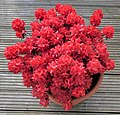
Best grown in a cool room with bright, indirect sunlight. Keep in a well-ventilated area with moderate humidity. You may need to mist regularly. In hot rooms with little ventilation, flowering buds may drop prematurely.
Azaleas must be grown in ericaceous compost, which must be used every time it is re-potted. When watering make sure that soft water is used, as if you live in a hard water area this will slowly kill the plant. In these areas, it is best to use water obtained from an outside water butt.
These 30-40cm mini shrubs have dark green glossy leaves, After flowering is over, trim the plant back and re-pot before placing outside for the summer. Feed Regularly and water outdoors over the summer period.
ROSA (Rose)
Roses are such attractive shrubs it would be a shame if they can only be found in the garden. Rose plants had to be bred to tolerate indoor conditions and at the same time have the familiar flower shape, colours, and scents. They also had to be bred to be more compact and as a result the flowers are smaller.
Indoor roses will bloom from early summer until the end of autumn, and are available in a large array of colours.

Rosa Chinensis var. minima is a small plant with pink double flowers, whilst ‘Baby Masquerade’ changes colours as they age. The buds are yellow but turn red as they open, creating a bicoloured effect all over the plant.
All indoor roses that grow up to 60cm in height have been bred from outdoor roses. This means that they need to be grown in full light, placing them in a sunny spot, like a windowsill. Keep them in a well-ventilated area. In winter, they will need complete rest, so cut back on the watering.
To keep plant flourishing, deadhead faded blooms regularly, as this will encourage new flowering buds to develop. Leaves will drop in autumn where it is an ideal time to remove any stems that have died back. Remembers roses have thorns so be careful when handling the plant.
SAINTPAULIA (African Violet)
This is an established favourite amongst indoor gardeners and this is partially due to its ability to remain in flowers all year round. This is so dependent on the level of care the plant obtains. The common name is given as the plant looks similar to a primrose.
The flower comes in shades of whites, pinks, or blues, over fluffy, dark green leaves.

African violets are not that easy to grow, as they need plenty of light throughout the year. In summer, they need shade from direct sunlight as the light can damage the leaves. This changes in winter, where the plant needs as much light as possible, so they need to be placed on a sunny windowsill.
African Violets need copious amounts of water and high humidity. Do not splash their leaves or growing crown whilst watering or misting as this can cause the plant to rot.
SCHLUMBERGERA
Schlumbergera x buckleyi is known as the Christmas or Easter cactus, depending on when it flowers. If you treat it right, masses of red, white or pink flowers on bright green, glossy leaves will appear, just in time for the festive period.
‘Bristol Beauty’ has purple-red flowers, whilst ‘Dumme’ has bright red flower and S. truncata has pink, white, orange, or red coloured flowers.
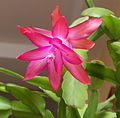
Unlike other succulents, it needs a compost with added organic material. It is often bought in flowers and should be watered, whilst still in bloom. After flowering has finished, cut back on watering for a few weeks.
Bring outside in summer where they will benefit in a shady spot with regular watering. Do not move once new flowering buds appear. Artificial light in autumn evenings can delay flowering.
This 35cm tall plant prefers to be grown in light shade, keeping the compost moist most of the time, more so when it is in flower.
SINNINGIA (GLOXINIA)
Gloxinia has such a large and glamorous flower. The red, pink, purple or white bright coloured trumpet-shaped flowers appear that makes the rest of the plant look insignificant. The fireworks normally happen in summer and autumn, where the blooms are produced.

Pinks and purples are the best to show off their velvety texture. ‘Red Tiger’ are beautifully speckled. The leaves themselves are large, flurry and dark green. This flowering houseplant can grow up to 40cm tall, where it must be watered with tepid (not cold) water. Grow this plant in bright, indirect light making sure it is never overwatered. An occasional misting will be required.
STEPHANOTIS (Madagascar Jasmine)
Stephanotis is an elegant, evergreen climber that can grow up to 6m in height. It had pure white, waxy, flowers that are set against dark green glossy, oval leaves. The flowers that are produced between spring and autumn provide an intoxicating scent that will waft around the home.

This is a long term indoor plant and it can be encouraged to flower year after year. Although meeting ideal conditions can be difficult to achieve. Grow in indirect sunlight, where in summer, it will frequent watering but sparsely in winter. Pruning will be required to keep it in shape so that it will fit into most homes.
STREPTOCARPUS (Cape Primrose)
What is not to like about this flower. It produces pretty small flowers of many different shades, is compact and bright looking, and is in flower from spring to autumn.
The flowers are borne on upright stems, often at least 4-5 per stem, where it will grow up to 60cm in height. Thin tubes open up into five rounded petals and the flowers have a backward sloping habit. This makes it a uniquely distinctive plant. The leaves themselves are interesting with distinct long, dark green shiny leaves.
Recently new cultivars have been developed to concentrate on plants with better flowering abilities. ‘Crystal Ice’ has been developed that flowers all year round. This flowering houseplant is popular but can be difficult to look after.
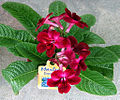
They need a steady fairly cool temperature, whilst at the same time being kept away from droughts. The plants will also need to be kept away from direct sunlight as this will cause damage, but at the same time, they will need to be exposed to bright, filtered light.
Watering is very important, keep the compost moist at all times, not dry, not wet. Whilst in active grown, apply a high potash liquid fertilizer. Not a difficult plant at all.
CONCLUSIONS
In this article, 32 of the best flowering houseplants to grow in your home has been discussed. There a number of species that can be grown covering all colours of the rainbow, forms, and growing heights.
These plants will provide a source of beauty in anybody’s home. Scent plants have been included to provide an extra dimension to the indoor gardener. All the relevant growing conditions have been enclosed, so that plants lost will be minimized.
Tell me what is your favourite indoor flowering plant.
If you have any questions that you wish to ask or comments to be made, please do so in the comment box below.
Happy container gardening.


I’ve read your article and I’ve come to the conclusion that I’d like to try growing Achimenes indoors, as you point out it is an easy choice to go with for a newbie like me.
I had a discussion with a friend of mine and she seems to be under the impression that this plant can attract thrips to feed, which will effect other indoor plants. Is this true or does this only happen in outdoor conditions?
Hi Chris
Thank you for your continual interest and I highly commend your choice. With any houseplant there is always a risk with pests but they can be dealt with by reading my article
Indoor Container Gardening (How to Get the Best from Your Indoor Plants)
Thanks
Antonio
Wow, interesting overview of the best among the houseplants flowers for homes. I like all the suggested ones and they all radiates ambience of beauty and elegance. However, you have pointed out their various requirements and how best to maintain them and that is great to know of. I like the Stephanotis the most. With the natural outlook of innocence and beauty. Thanks
Hi RoDarrick
To be truthful you have selected my personal favourite, as Stephanotis is such a delightful plant to look at and the scent is so devine. I have tried to be comprehensive in the terms of houseplants that are suitable, some easy to look after, others more difficult. I am trying to give people a larger choice.
Thanks
Antonio
We have found a very good list to decorate our house inside with flowers.
There is a lot of variety, and the best thing is that we can see how we have to take care of them, I am not very good at this, but I am sure that this will help me a lot to learn and to be able to help my wife with this.
Good luck with your post and the truth is that I loved your blog.
Hi Emmanuel
If you look after your plants well, the plants will look after you. Flowering plants are a must for all homes, as they add an extra dimension, which is missing if it is not there. I also try to educate with my articles and thank you for taking an interest.
Thanks
Antonio
Wow, this is a very long article about plants! You make it really hard to choose one ;). Although I have to say that the queen’s tear and the lily of the valley, if just by name :D. But I think they might be too much taking care of for me personally… Great article with great flowers, a few of them I hadn’t even heard about, would you think that makes it hard to find them as well? I don’t really see if some flowers are hard to get by or not…
Hi Virendra
More choices is better than no choices at all. Houseplants can be difficult to do but my guide to getting the best in indoor plants should help.Indoor Container Gardening (How to Get the Best from Your Indoor Plants). I recommend always start with those plants that can take some neglect, before moving on to more difficult plants. Get confident before moving on.
Thanks
Antonio
Adding flowers is a great way to add color to your home. The color from flowers is so natural to. I like the Italian Bellflower it has a nice solid shape. Lily of the valley? Wasn’t that featured in a TV show a few years back? Maybe it was fictional or a slightly different name.
I like the heliotrope it sounds like it will have a nice smell. That’s another great thing about having flowers inside, the great smell. I would probably get some Jasmine and some Rose grape. The other names are so complicated! Thanks for the article and nice pictures.
Hi Jen
Flowers bring colour, they bring scents and they clean the home atmosphere. What more can you ask. Helletropes are such a delightful scented plant that you wonder what you did before you had some.
The named are not complicated as it uses the Latin to help you buy the plants and not get the wrong one. I am trying to help the house gardener as much as possible.
Thanks
Antonio
I can’t say the number of house plants I have tried keeping only for them die. I have mainly gone for those that are grown for leaves other than for flowers. I am now wondering to myself, why haven’t I tried flowering plants?
I love how the Billbergia looks. Simple yet sophisticated. Once a month fertilizer is double and I do not think it feels like a task. We also have a lot of Hibiscus in our area and I think I will also try this one. I love that chances of it flowering are very high. Cannot wait to see what colors they come out in.
Thank you for this awesome suggestions. much appreciated!
Hi Carol
As said in the article, some are easy to look after, whilst others are more difficult to get the growing conditions right. If you want to wet your fingers then I would suggest growing those which are no fuss in how they grow, in this way you will become more confident in your gardening skills.Once you are more practice then you can go onto more difficult plants.
Thanks
Antonio
Hi Antonio,
You really made my morning with these beautiful flowers.
With winter around the corner, this will be the way to be outside while you are still inside.
I love orchid and hibiscus to have.
Just a query for if you here: I was pleasantly surprised to see a mango plant (not flowers nor but they have a nice smell) my keyhole garden inside waste collector). Is their way to get it inside and make it survive until the next summer?
Flowers relieve stress. I love them as pets. I have jasmine now on my desk. The smell of it is so pleasing, it refreshes you.
It is absolutely a great compilation with necessary details on how to grow flowers inside your home.
Hi Anusha
Thank you for you visit to my website.
To answer your question, is it depends where you live. If you live in a hot sunny climate that gets no frost then it can be kept outside all year. If it gets cold then you can bring them inside in winter and move it outside during summer. The only problem is that it is a tree and will get more difficult to move, unless you use a trolley
Moving Pots in the Container Garden –Wheeled Garden Plant Pot Reviewed
Hope this helps.
Antonoo
Hi Antonio. So many plants I have never seen or heard of! I’ve heard only of Cyclamen, Heliotropium, Geranium and Azalea. Mostly because my mother is a gardener and buys plants quite frequently.
When it comes to shape and color, I like the Achimenes, Hibiscus, Hippeastrum, Pericallis. Pericallis especially, because I have rarely seen blue flowers. Maybe I could get one of these as a gift.
I’ve seen some cactuses planted in my house but this cactus you have that is named Haageocereus looks way cooler.
I’m glad I stumbled upon your article and took a peek at some cool flowers. Although not a gardener at the moment, that doesn’t mean anything. Maybe I will be next year, who knows! Have a nice day.
Hi George
It is my pleasure, as I wanted to inspire those with indoor gardens to have beautiful blooms in their home. A larger selection means more choice and more likelihood of success.
Thanks
Antonio